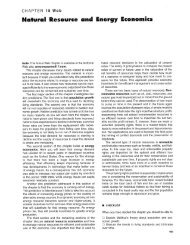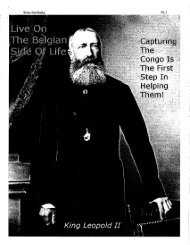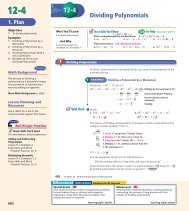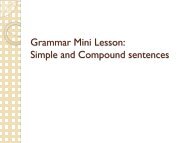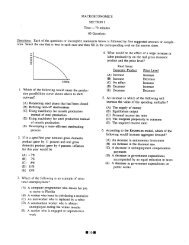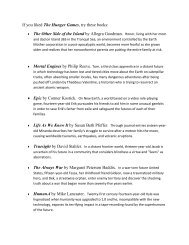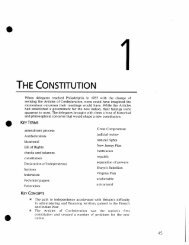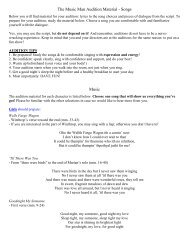The Female Artist in Kate Chopin's The Awakening: Birth and ...
The Female Artist in Kate Chopin's The Awakening: Birth and ...
The Female Artist in Kate Chopin's The Awakening: Birth and ...
Create successful ePaper yourself
Turn your PDF publications into a flip-book with our unique Google optimized e-Paper software.
<strong>The</strong> <strong>Female</strong> <strong>Artist</strong> <strong>in</strong> <strong>Kate</strong> Chop<strong>in</strong>'s <strong>The</strong> Awaken<strong>in</strong>g: <strong>Birth</strong> <strong>and</strong><br />
Creativity<br />
Author(s): Carole Stone<br />
Publication Details: Women's Studies 13 (1986): p23-32.<br />
Source: Twentieth-Century Literary Criticism.<br />
Ed. Janet Witalec. Vol. 127. Detroit: Gale, 2002. From Literature Resource Center.<br />
Document Type: Critical essay<br />
Full Text: COPYRIGHT 2002 Gale, COPYRIGHT 2007 Gale, Cengage Learn<strong>in</strong>g<br />
Full Text:<br />
[(essay date 1986) In the follow<strong>in</strong>g essay, Stone views Chop<strong>in</strong>'s birth imagery <strong>in</strong> <strong>The</strong><br />
Awaken<strong>in</strong>g as symbolic of the birth of Edna Pontellier as an artist.]<br />
When <strong>Kate</strong> Chop<strong>in</strong>'s <strong>The</strong> Awaken<strong>in</strong>g was published <strong>in</strong> 1899 critics attacked its depiction<br />
of a hero<strong>in</strong>e who sought sexual pleasure outside of marriage <strong>and</strong> condemned Chop<strong>in</strong><br />
for "fail<strong>in</strong>g to perceive that the relation of a mother to her children is far more important<br />
than the gratification of a passion which experience has taught her is ... evanescent." 1<br />
But <strong>The</strong> Awaken<strong>in</strong>g is even more radical <strong>in</strong> its treatment of motherhood because it<br />
questions the assumptions that childbirth <strong>and</strong> child care are a woman's pr<strong>in</strong>cipal<br />
vocation, <strong>and</strong> that motherhood gives pleasure to all women.<br />
In Chop<strong>in</strong>'s era childbirth was considered a woman's noblest act; to write of it otherwise<br />
was unacceptable. Thus, the cl<strong>in</strong>ical details of pregnancy <strong>and</strong> birth<strong>in</strong>g rema<strong>in</strong>ed largely<br />
unwritten. As Dr. M<strong>and</strong>elet tells Edna <strong>in</strong> <strong>The</strong> Awaken<strong>in</strong>g. "<strong>The</strong> trouble is that youth is<br />
given up to illusions. It seems to be a provision of Nature to secure mothers for the<br />
race." 2 But Dr. M<strong>and</strong>elet's <strong>in</strong>sight is rare for a man because he is a physician. By<br />
shatter<strong>in</strong>g the illusion that giv<strong>in</strong>g birth is a glorious experience, Chop<strong>in</strong> attacks the<br />
patriarchal structure which denies women control of their bodies. In addition, however,<br />
she goes beyond naturalism <strong>in</strong> her use of the birth motif. On the symbolic level birth<strong>in</strong>g<br />
is a metaphor for the rebirth of the book's protagonist, Edna Pontellier, as artist. <strong>The</strong><br />
novel can be read as a depiction of the growth of the female artist, a bildungsroman, <strong>in</strong><br />
which birth is emphasized as unique to the female experience.
Many recent critics of <strong>The</strong> Awaken<strong>in</strong>g fail to see Edna's grow<strong>in</strong>g sense of power <strong>and</strong><br />
control as signs of progress toward a new self-def<strong>in</strong>ition. <strong>The</strong>y view her as a woman<br />
deluded by romanticism who is unable to make a conscious choice, such as the<br />
decision to become an artist, because her <strong>in</strong>st<strong>in</strong>cts are regressive. Cynthia Griff<strong>in</strong> Wolff,<br />
for example, considers Edna passive, an artist at the mercy of her work. Further, she<br />
f<strong>in</strong>ds that for Edna birth is a pyschic trauma awaken<strong>in</strong>g her to the impossibility of total<br />
fusion with another. 3 Another critic, Suzanne Wolkenfeld, considers that Edna's<br />
"experience of rebirth is not directed toward new life, but backward to the womb." 4 And<br />
James Justus observes that Edna's "awaken<strong>in</strong>g is not an advance towards a new<br />
def<strong>in</strong>ition of self but a return to the protective self-evident identity of childhood," 5 while<br />
Donald A. R<strong>in</strong>ge considers Edna's romanticism part of a voyage of transcendental self-<br />
discovery, but concludes that Chop<strong>in</strong> "allows her character no limitless expansion of<br />
self." 6 A more recent critic, Carole Christ, views Edna's awaken<strong>in</strong>g <strong>in</strong> a positive light,<br />
see<strong>in</strong>g her evolv<strong>in</strong>g sense of self as spiritual rebirth. However, Christ, too, f<strong>in</strong>ds Edna<br />
ultimately socially defeated <strong>in</strong> spite of the very important fact that this hero<strong>in</strong>e grows as<br />
an artist. 7<br />
In this essay I will argue that Edna's memories of her childhood, her immersion <strong>in</strong> the<br />
sea, <strong>and</strong> her search for a mother figure are emblems of regression <strong>in</strong> the service of<br />
progression toward an artistic vocation. Rather than return<strong>in</strong>g to the dependency of<br />
childhood, she goes forward to a new conception of self, a def<strong>in</strong>ition of herself as artist.<br />
Further, I will suggest that Edna's romanticism is positive because it catalyzes her<br />
imag<strong>in</strong>ative power. As the f<strong>in</strong>al step forward function<strong>in</strong>g as an autonomous human<br />
be<strong>in</strong>g, moreover, she sees through the delusion of romantic love after confront<strong>in</strong>g the<br />
horror of giv<strong>in</strong>g birth.<br />
Edna's artistic birth<strong>in</strong>g is shown through the contrast<strong>in</strong>g characters of two women, Adèle<br />
Ratignolle, a "mother-woman," <strong>and</strong> Mme. Reisz, a pianist. As Per Seyersted has<br />
observed, "the novel covers two generations <strong>and</strong> births ... a f<strong>in</strong>ely wrought system of<br />
tensions <strong>and</strong> <strong>in</strong>terrelations set up between Edna's slow birth as authentic <strong>and</strong> sexual<br />
be<strong>in</strong>g <strong>and</strong> the counterpo<strong>in</strong>ted pregnancy <strong>and</strong> conf<strong>in</strong>ement of Adèle." 8 Adèle embodies
female biology, always talk<strong>in</strong>g of her condition, for she has a baby about every two<br />
years. Adèle's opposite, Mme. Reisz, a serious artist, is unmarried. She exemplifies the<br />
solitary life of the dedicated artist.<br />
A third <strong>in</strong>fluence on Edna's artistic development is Robert LeBrun, a young Creole man<br />
who, because he has not yet assumed the mascul<strong>in</strong>e values of his society, can be a<br />
friend to Edna as her husb<strong>and</strong> cannot. He teaches her to swim, further<strong>in</strong>g her<br />
autonomy, <strong>and</strong> with his easy way of talk<strong>in</strong>g about himself, encourages her self-<br />
expression. Because he has aroused sexual desire <strong>in</strong> her, she eventually has an affair<br />
with another man, Alcée Arob<strong>in</strong>, an affair which functions as a rite of passage to sexual<br />
autonomy.<br />
Each of these three figures has positive <strong>and</strong> negative qualities that help <strong>and</strong> h<strong>in</strong>der<br />
Edna's struggle to be creative. Adèle Ratignolle, a sensuous woman, awakes Edna to<br />
the sensuality of her own body. Also Adèle's c<strong>and</strong>or <strong>in</strong> talk<strong>in</strong>g about such subjects as<br />
her pregnancy helps Edna to overcome her reserve. Furthermore, Adèle encourages<br />
her to express thoughts <strong>and</strong> feel<strong>in</strong>gs she had kept hidden, even from herself. For<br />
example, at Adèle's urg<strong>in</strong>g to say what she is th<strong>in</strong>k<strong>in</strong>g as they sit together by the sea,<br />
Edna recalls "a summer day <strong>in</strong> Kentucky, of a meadow that seemed as big as the ocean<br />
to the very little girl ... She threw out her arms as if swimm<strong>in</strong>g when she walked, beat<strong>in</strong>g<br />
the tall grass as one strikes out <strong>in</strong> the water." (17) When Edna says that she feels as if<br />
this summer is like walk<strong>in</strong>g through that meadow aga<strong>in</strong> "unguided," Adèle strokes her<br />
h<strong>and</strong>, <strong>and</strong> we see that <strong>in</strong> fact, though not an artist, it is she who guides Edna toward<br />
warmth, openness, <strong>and</strong> creativity. For Edna's memory is an important step <strong>in</strong> the growth<br />
of her power of free association, necessary <strong>in</strong> the creative process.<br />
In these early scenes by the sea Chop<strong>in</strong> also establishes the sea as a central symbol<br />
for Edna's birth<strong>in</strong>g of a new self. <strong>The</strong> connection <strong>in</strong> her m<strong>in</strong>d between the grass <strong>and</strong> the<br />
sea foreshadows the autonomy she achieves by learn<strong>in</strong>g to swim, as well as her f<strong>in</strong>al<br />
walk <strong>in</strong>to the sea at the book's end. Symbolically, the sea is both a generative <strong>and</strong> a<br />
destructive force <strong>in</strong> <strong>The</strong> Awaken<strong>in</strong>g; it represents danger <strong>in</strong>herent <strong>in</strong> artistic self-
expression--los<strong>in</strong>g oneself <strong>in</strong> unlimited space--as well as the source of all life, facilitat<strong>in</strong>g<br />
rebirth, so that Edna <strong>in</strong> her first moments of be<strong>in</strong>g able to swim feels like a child who<br />
has learned to walk. <strong>The</strong> ocean has also been seen as a symbol of woman or the<br />
mother <strong>in</strong> both her benevolent <strong>and</strong> terrible aspects. Madame Ratignolle, <strong>in</strong> association<br />
with the sea, represents the benevolent mother who nurtues Edna <strong>and</strong> even <strong>in</strong>spires<br />
her to pa<strong>in</strong>t. Adèle seems to her, as she is seated on the beach, like "some sensuous<br />
Madonna," <strong>and</strong> she pa<strong>in</strong>ts her picture.<br />
At this beg<strong>in</strong>n<strong>in</strong>g po<strong>in</strong>t <strong>in</strong> her artistic development Edna th<strong>in</strong>ks of herself as a "dabbler."<br />
However, though Edna has had no formal tra<strong>in</strong><strong>in</strong>g, Chop<strong>in</strong> establishes the fact that she<br />
is talented for "she h<strong>and</strong>led her brushes with a certa<strong>in</strong> ease <strong>and</strong> freedom which came<br />
not from a long <strong>and</strong> close acqua<strong>in</strong>tance with them but from a natural aptitude." (12) We<br />
also see early on that Edna has the capacity for self-criticism as "after survey<strong>in</strong>g the<br />
sketch critically, she drew a broad smudge of pa<strong>in</strong>t across its surface <strong>and</strong> crumpled the<br />
paper between her h<strong>and</strong>s." (12) Later when Edna's critical faculties are turned aga<strong>in</strong>st<br />
conventional values of home, husb<strong>and</strong>, <strong>and</strong> family <strong>in</strong> the direction of autonomy, Adèle<br />
will show the negative side of her mother<strong>in</strong>g qualities. By constantly rem<strong>in</strong>d<strong>in</strong>g Edna of<br />
her duty to her children, she b<strong>in</strong>ds her to society's rules <strong>and</strong> impedes her creative<br />
growth.<br />
In these early scenes at Gr<strong>and</strong> Isle where Edna's struggle to be an artist is beg<strong>in</strong>n<strong>in</strong>g,<br />
Robert is another source of imag<strong>in</strong>ative power. As she pa<strong>in</strong>ts Adèle's portrait, he<br />
encourages her with "expressions of appreciation <strong>in</strong> French." While this may simply be<br />
Creole flattery, it is more encouragement than she has ever received from her husb<strong>and</strong>.<br />
Like Adèle, he is sensual, <strong>and</strong> as she pa<strong>in</strong>ts he rests his head aga<strong>in</strong>st her arm. He also<br />
speaks about himself freely, tell<strong>in</strong>g her of his plans to go to Mexico. Under his <strong>in</strong>fluence<br />
she speaks to him about her life, <strong>and</strong> it is he who awakens her to the passions of her<br />
body. A few weeks after the pa<strong>in</strong>t<strong>in</strong>g scene on the beach, Chop<strong>in</strong> aga<strong>in</strong> uses the sea as<br />
a symbol of growth, <strong>and</strong> aga<strong>in</strong> <strong>in</strong> connection with Robert. One even<strong>in</strong>g he proposes a<br />
night swim <strong>and</strong> we see him l<strong>in</strong>ger<strong>in</strong>g beh<strong>in</strong>d with the lovers, "<strong>and</strong> there was not one but<br />
was ready to follow when he led the way." (28) Robert's appearance is associated
frequently with lovers; he becomes Cupid who awakens Edna to the force of Eros. This<br />
even<strong>in</strong>g she learns to swim <strong>and</strong> feels herself "reach<strong>in</strong>g out for the unlimited <strong>in</strong> which to<br />
lose herself." (30) Loss of boundaries suggests orgiastic union which foreshadows<br />
Edna's f<strong>in</strong>al merg<strong>in</strong>g with the sea. Significantly, that even<strong>in</strong>g as she lies <strong>in</strong> a hammock,<br />
an image of lovemak<strong>in</strong>g, she feels herself "pregnant with the first felt throbb<strong>in</strong>g desire"<br />
(32) for Robert.<br />
When her husb<strong>and</strong> returns later she refuses to go <strong>in</strong>side when he asks her to. By now<br />
she has achieved mastery over her body by learn<strong>in</strong>g to swim <strong>and</strong> mastery over her<br />
environment by challeng<strong>in</strong>g his authority. She now has to achieve mastery over her<br />
imag<strong>in</strong>ation, but at this po<strong>in</strong>t can only "bl<strong>in</strong>dly follow whatever impulse moved her." (34)<br />
Next morn<strong>in</strong>g, without much thought, she asks a servant to tell Robert she wishes him<br />
to take the boat with her to Cheniere for Mass. Walk<strong>in</strong>g to the wharf, there are, as<br />
always when Robert appears, lovers who already stroll "shoulder to shoulder." Edna's<br />
imag<strong>in</strong>ation is subsumed by the romance phase of her creative growth as she spends<br />
an idyllic day with Robert. This chapter could be considered an epithalamion which, like<br />
Edmund Spenser's, is governed by the position of the sun dur<strong>in</strong>g each part of the<br />
marriage day. On the boat trip, "<strong>The</strong> lovers were all along. <strong>The</strong>y saw noth<strong>in</strong>g, they heard<br />
noth<strong>in</strong>g." (36) Edna <strong>and</strong> Robert became like the lovers, <strong>in</strong>fatuated with each other, as<br />
the sun was high up <strong>and</strong> beg<strong>in</strong>n<strong>in</strong>g to bite." (36)<br />
Edna grows tired <strong>in</strong> church dur<strong>in</strong>g Mass, <strong>and</strong> we see her reject another of society's<br />
<strong>in</strong>stitutions of authority <strong>in</strong> favor of the natural force of Eros. Robert takes her to the<br />
home of Madame Anto<strong>in</strong>e where Edna partially removes her clothes <strong>and</strong> while Robert<br />
waits for her outside, lies down "<strong>in</strong> a strange, qua<strong>in</strong>t bed, with its country odor of the<br />
laurel, l<strong>in</strong>ger<strong>in</strong>g about the sheets <strong>and</strong> mattress." (39) <strong>The</strong> laurel, expressive of victory<br />
<strong>and</strong> celebration, is a tree sacred to Apollo, <strong>and</strong> s<strong>in</strong>ce the sun charts the course of this<br />
harmonious day, the association is clear. <strong>The</strong> festival be<strong>in</strong>g celebrated is a mock<br />
wedd<strong>in</strong>g, <strong>and</strong> the hammock which Edna slept <strong>in</strong> the night before has been replaced by<br />
the marriage bed.
Edna wakes to an Edenic world of simple pleasure <strong>and</strong> magical properties. Beside her<br />
bed are bread <strong>and</strong> w<strong>in</strong>e, symboliz<strong>in</strong>g communion. Outside she picks an orange from a<br />
tree <strong>in</strong> a natural paradise where, Robert tells her, she has slept for a hundred years<br />
while he guarded her. As the day ends they watch the sun "turn<strong>in</strong>g the western sky to<br />
flam<strong>in</strong>g copper <strong>and</strong> gold," (41) as Madame Anto<strong>in</strong>e tells them stories. She represents<br />
the oral tradition of art, a simple phase which Edna can enjoy <strong>and</strong> emulate. On the boat<br />
trip back, Edna hears "the whisper<strong>in</strong>g voices of dead men <strong>and</strong> the click of muffled gold."<br />
(42) This day is the high po<strong>in</strong>t of romance <strong>in</strong> Edna's imag<strong>in</strong>ation, <strong>and</strong> she will return to it<br />
<strong>in</strong> her memory as she pa<strong>in</strong>ts, <strong>and</strong> as she repeats Madame Anto<strong>in</strong>e's stories.<br />
<strong>The</strong> woman who represents a structured form of art is Mme. Reisz, the true artist Edna<br />
wishes to become. While Madame Ratignolle plays the piano solely for the pleasure of<br />
her family, Mme. Reisz plays Frederic Chop<strong>in</strong> with great feel<strong>in</strong>g <strong>and</strong> art. Before hear<strong>in</strong>g<br />
Mme. Reisz play, music had evoked pictures <strong>in</strong> Edna's m<strong>in</strong>d. After listen<strong>in</strong>g to her play,<br />
Edna's passions are aroused. But like such n<strong>in</strong>eteenth century female artists as Emily<br />
Dick<strong>in</strong>son, Mme. Reisz is unmarried, childless, eccentric <strong>in</strong> manner <strong>and</strong> <strong>in</strong> dress, <strong>and</strong><br />
alienated from society. She cannot serve as a role model for Edna. Nevertheless,<br />
Edna's creative development cont<strong>in</strong>ues. After the family's return to New Orleans, she<br />
takes up her pa<strong>in</strong>t<strong>in</strong>g once more <strong>in</strong> spite of her husb<strong>and</strong>'s admonishment that she "not<br />
let the family go to the devil" while she pa<strong>in</strong>ts. She works with "great energy <strong>and</strong><br />
<strong>in</strong>terest" though she feels she is not accomplish<strong>in</strong>g anyth<strong>in</strong>g. Often she s<strong>in</strong>gs "Ah tu<br />
savais," the song Robert sang on Gr<strong>and</strong> Isle, <strong>and</strong> she recalls:<br />
the ripple of the water, the flapp<strong>in</strong>g sail. She could see the gl<strong>in</strong>t of the moon upon the<br />
bay, <strong>and</strong> could feel the soft, gusty beat<strong>in</strong>g of the hot south w<strong>in</strong>d. A subtle current of<br />
desire passed through her body, weaken<strong>in</strong>g her hold upon the brushes <strong>and</strong> mak<strong>in</strong>g her<br />
eyes burn.(62)<br />
On the one h<strong>and</strong> romance limits her work, but on the other h<strong>and</strong> it is a source of<br />
<strong>in</strong>spiration.
<strong>The</strong>re are factors beyond Edna's control, however, which limit her development. Gilbert<br />
<strong>and</strong> Gubar, <strong>in</strong> a discussion of the woman writer <strong>in</strong> patriarchal society, describe "the<br />
lonel<strong>in</strong>ess of the female artist, her feel<strong>in</strong>gs of alienation from male predecessors<br />
coupled with her need for sisterly precursors <strong>and</strong> successors, her urgent need for a<br />
female audience." 9 Certa<strong>in</strong>ly this describes Edna's situation as she seeks out her two<br />
contrast<strong>in</strong>g women friends for validation, Mme. Reisz <strong>and</strong> Adèle Ratignolle. She br<strong>in</strong>gs<br />
her pa<strong>in</strong>t<strong>in</strong>gs to Adèle even though she knows <strong>in</strong> advance, "her op<strong>in</strong>ion <strong>in</strong> such a matter<br />
would be next to valueness ... but she sought the words of praise <strong>and</strong> encouragement<br />
that would help her to put heart <strong>in</strong>to her venture." (59) Adèle, true to her character as a<br />
"mother-woman," tells her that her talent is immense, <strong>and</strong> Edna is pleased even though<br />
she recognizes "its true worth." She receives a much harsher judgement of her artistic<br />
capacity from Mme. Reisz. In reply to the question of what she has been do<strong>in</strong>g, Edna<br />
tells her "I am becom<strong>in</strong>g an artist" <strong>and</strong> her friend says, "Ah! an artist. You have<br />
pretensions, Madame." (68) Sens<strong>in</strong>g the <strong>in</strong>security which keeps her from total<br />
commitment to art, Mme. Reisz warns, "To be an artist <strong>in</strong>cludes much; one must<br />
possess many gifts--absolute gifts--which have not been acquired by one's own effort.<br />
And moreover, to succeed the artist must possess the courageous soul." (68)<br />
But there is much evidence to show the growth <strong>in</strong> Edna's capacity to be an artist. She is<br />
learn<strong>in</strong>g to enjoy solitude, <strong>and</strong> her teacher, an art dealer, observes that her work "grows<br />
<strong>in</strong> force <strong>and</strong> <strong>in</strong>dividuality." At a d<strong>in</strong>ner party she tells the Baratarian story she heard from<br />
Madame Anto<strong>in</strong>e, <strong>and</strong> her imag<strong>in</strong>ation has grown so much that she makes "every<br />
glow<strong>in</strong>g word seem real" to her listeners. Shortly after, she moves out of her husb<strong>and</strong>'s<br />
house, us<strong>in</strong>g money from an <strong>in</strong>heritance <strong>and</strong> from the sale of her pa<strong>in</strong>t<strong>in</strong>gs, <strong>in</strong>to a<br />
smaller house of her own. Edna's little house, like Woolf's "room of one's own," is a<br />
symbol for grow<strong>in</strong>g psychic <strong>and</strong> f<strong>in</strong>ancial <strong>in</strong>dependence. In addition, even more<br />
important than these actions, Edna has def<strong>in</strong>ed herself as an artist. Jok<strong>in</strong>gly she says to<br />
Mme. Reisz, "You see that I have persistence. Does that quality count for anyth<strong>in</strong>g <strong>in</strong><br />
art?" (68) Indeed it does. Edna pa<strong>in</strong>ts even though she lacks the serious criticism from<br />
others that could help her shape her art <strong>and</strong> despite the fact that she misses the support<br />
of women artists who underst<strong>and</strong> the special obstacles that impede female creativity.
Two events occur almost simultaneously at the novel's climax, events which portray the<br />
forces that f<strong>in</strong>ally defeat Edna's search for artistic wholeness. One is her witness<strong>in</strong>g of<br />
Adèle's suffer<strong>in</strong>g <strong>in</strong> child-birth <strong>and</strong> the other is Robert's admitt<strong>in</strong>g that he loves her <strong>and</strong><br />
wants to marry her. Edna has gone to Adèle, leav<strong>in</strong>g Robert just after he tells her he<br />
has dreamed of marry<strong>in</strong>g her if her husb<strong>and</strong> will free her. She has replied that she is no<br />
longer one of Mr. Pontellier's possessions to be given away. When she returns from<br />
Adèle's he is gone, hav<strong>in</strong>g expla<strong>in</strong>ed <strong>in</strong> a note that he has left not because he doesn't<br />
love her but because he does. Robert has been deeply connected to her sexual growth,<br />
which <strong>in</strong> turn affected the growth of her imag<strong>in</strong>ation. Through him she has begun to<br />
transfer the authenticity of her romantic vision to her pa<strong>in</strong>t<strong>in</strong>gs. Now, romantic illusions<br />
shattered, she loses the catlyst for her art.<br />
<strong>The</strong> other illusion that is shattered is that of childbirth be<strong>in</strong>g a moment of joy. Edna does<br />
not remember her own pa<strong>in</strong> when she gave birth, s<strong>in</strong>ce she was chloroformed. Now,<br />
see<strong>in</strong>g Adèle's pa<strong>in</strong>, she recognizes that she cannot rebel aga<strong>in</strong>st nature. Adèle's<br />
part<strong>in</strong>g words "th<strong>in</strong>k of the children" rem<strong>in</strong>d her of her mother-role which conflicts with<br />
her new-found freedom. Chop<strong>in</strong> was far ahead of her time <strong>in</strong> expos<strong>in</strong>g the myth of<br />
bear<strong>in</strong>g children as a woman's ultimate fulfillment, call<strong>in</strong>g Adèle's "acouchement" a<br />
scene of torture. Almost a century later Sylvia Plath was to use the same image <strong>in</strong> <strong>The</strong><br />
Bell Jar by describ<strong>in</strong>g the delivery room as "some awful torture chamber." 10 And a<br />
doctor tells Plath's protagnist Esther, just as Dr. M<strong>and</strong>elet told Edna, "<strong>The</strong>y oughtn't to<br />
let women watch. You'll never want a baby if you do. It'll be the end of the human<br />
race." 11<br />
<strong>The</strong> next morn<strong>in</strong>g Edna returns to Gr<strong>and</strong> Isle <strong>and</strong> walks to her death <strong>in</strong> the sea. Is her<br />
suicide triggered by Adèle's suffer<strong>in</strong>g <strong>in</strong> childbirth? By the knowledge that it is futile to<br />
rebel aga<strong>in</strong>st biology? Does she kill herself because Robert has left her? Or because<br />
she has failed to become an artist? Edna drowns herself because she cannot live as a<br />
conventional wife or mother any longer, <strong>and</strong> society will not accept her newfound self.<br />
<strong>The</strong> solitude she enjoys makes for artistic growth, but she is bound to children, home,<br />
social duty. She will not sacrifice her new autonomy because, as Anne Jones po<strong>in</strong>ts out,
"she will not rel<strong>in</strong>quish the core of her vision, which is not f<strong>in</strong>ally romance, but rather her<br />
own autonomous be<strong>in</strong>g ... so she freely goes to the sea, los<strong>in</strong>g her life. But she does<br />
not lose her self." 12<br />
By beg<strong>in</strong>n<strong>in</strong>g <strong>and</strong> end<strong>in</strong>g <strong>The</strong> Awaken<strong>in</strong>g with the sea Chop<strong>in</strong> gives the book a<br />
wholeness that Edna cannot f<strong>in</strong>d <strong>in</strong> her life. Furthermore, Chop<strong>in</strong>'s themes of<br />
sea/mother, love/lover, self/birth, sexuality/creativity are jo<strong>in</strong>ed as Edna's birth of a new<br />
self is juxtaposed aga<strong>in</strong>st Adèle's giv<strong>in</strong>g birth to another. In a moment of liberty she<br />
st<strong>and</strong>s naked on the beach feel<strong>in</strong>g like "some new-born creature" before enter<strong>in</strong>g the<br />
sea which becomes the universal Great Mother. To be sure, Chop<strong>in</strong> uses one image of<br />
defeat, the "bird with the broken w<strong>in</strong>g," which Edna sees "reel<strong>in</strong>g, flutter<strong>in</strong>g, circl<strong>in</strong>g,<br />
disabled down down to the water." (124) This was the image used by Mlle. Reisz when,<br />
as if predict<strong>in</strong>g Edna's fall she said, "it is a sad spectacle to see the weakl<strong>in</strong>g bruised,<br />
exhausted, flutter<strong>in</strong>g back to earth." (89) But how strong must a woman be at this time<br />
<strong>in</strong> order to ma<strong>in</strong>ta<strong>in</strong> her artistic vocation without any support from community? Certa<strong>in</strong>ly<br />
Mlle. Reisz has given Edna no encouragement, so Edna th<strong>in</strong>ks of how she would have<br />
laughed at her, of Robert who would never underst<strong>and</strong>, <strong>and</strong> of her children who "sought<br />
to drag her <strong>in</strong>to the soul's slavery." (123)<br />
Yet Edna's f<strong>in</strong>al moment is one of autonomous sexuality, as the world of her imag<strong>in</strong>ation<br />
resonates with fertility--"<strong>The</strong>re was the hum of bees, <strong>and</strong> the musky odor of p<strong>in</strong>ks filled<br />
the air." (125) Chop<strong>in</strong> repeats the description of the sea which describes Edna's first<br />
swim, "<strong>The</strong> touch of the sea is sensuous, enfold<strong>in</strong>g the body <strong>in</strong> its soft, close embrace,"<br />
(124) <strong>and</strong> with this symbolic closure portrays Edna becom<strong>in</strong>g whole <strong>in</strong> the only way she<br />
can, by immersion <strong>in</strong> the universal sea of love. But how can Edna's death be positive?<br />
Many critics th<strong>in</strong>k it is not. 13 Wolff, for example, uses it as further evidence of Edna's<br />
regressive <strong>in</strong>st<strong>in</strong>cts. 14 Christ believes that while the end<strong>in</strong>g of the novel was realistic for<br />
its time, suicide as a resolution cannot satisfy women now. 15 Nevertheless, Edna<br />
Pontellier succeeds <strong>in</strong> giv<strong>in</strong>g birth to a new self even though the fact that she can not<br />
live on earth as this new self is tragic. <strong>The</strong> triumph of <strong>The</strong> Awaken<strong>in</strong>g lies <strong>in</strong> Chop<strong>in</strong>'s<br />
depict<strong>in</strong>g, when others did not, the conflicts faced by women who wish to become
artists. Courageously, she built <strong>in</strong> her novel a bridge from past to future so that women<br />
might f<strong>in</strong>d their way across. Like her hero<strong>in</strong>e, she too was a pontellier, a bridgemaker.<br />
Notes<br />
1 C. L. Deyo, "<strong>The</strong> Newest Books," St. Louis Post-Dispatch, May 20, 1899, quoted <strong>in</strong><br />
<strong>Kate</strong> Chop<strong>in</strong>, <strong>The</strong> Awaken<strong>in</strong>g, an authoritative text, Context, Criticisms (New York,<br />
Norton, 1976), p. 149.<br />
2 <strong>Kate</strong> Chop<strong>in</strong>, <strong>The</strong> Awaken<strong>in</strong>g & Selected Stories of <strong>Kate</strong> Chop<strong>in</strong> (New York: <strong>The</strong> New<br />
American Library, 1976), p. 120. All quotes are cited from this edition,<br />
3 Cynthia Griff<strong>in</strong> Wolff, "Thanatos <strong>and</strong> Eros: <strong>Kate</strong> Chop<strong>in</strong>'s <strong>The</strong> Awaken<strong>in</strong>g," American<br />
Quarterly XXV (Oct. 1973), pr<strong>in</strong>ted <strong>in</strong> <strong>The</strong> Awaken<strong>in</strong>g, ed. Culley, p. 212, 217.<br />
4 Suzanne Wolkenfeld, "Edna's Suicide: <strong>The</strong> Problem of the One <strong>and</strong> the Many," <strong>in</strong> <strong>The</strong><br />
Awaken<strong>in</strong>g ed. Culley, p. 223.<br />
5 James Justus, "<strong>The</strong> Unawaken<strong>in</strong>g of Edna Pontellier." Southern Literary Journal, X<br />
(Spr<strong>in</strong>g, 1978), p. 112.<br />
6 Donald A. R<strong>in</strong>ge, "Romantic Imagery <strong>in</strong> <strong>Kate</strong> Chop<strong>in</strong>'s <strong>The</strong> Awaken<strong>in</strong>g," American<br />
Literature, 43 (January, 1972), repr<strong>in</strong>ted <strong>in</strong> <strong>The</strong> Awaken<strong>in</strong>g, ed. Culley, p. 206.<br />
7Carol P. Christ, Div<strong>in</strong>g Deep <strong>and</strong> Surfac<strong>in</strong>g: Women Writers on Spiritual Quest (Boston:<br />
Beacon Press, 1980), p. 35.<br />
8 Per Seyersted, <strong>Kate</strong> Chop<strong>in</strong>: A Critical Biography (Baton Rouge: Louisiana State<br />
University Press, 1969), p. 153.<br />
9 S<strong>and</strong>ra Gilbert <strong>and</strong> Susan Gubar, <strong>The</strong> Madwoman <strong>in</strong> the Attic: <strong>The</strong> Woman Writer <strong>and</strong><br />
the N<strong>in</strong>eteenth Century Literary Imag<strong>in</strong>ation (New Haven: Yale University Press, 1979),<br />
p. 50.
10 Sylvia Plath, <strong>The</strong> Bell Jar (New York: Harper & Row, 1971), p. 53.<br />
11 Plath, p. 53.<br />
12 Anne Goodwyn Jones, Tomorrow Is Another Day: <strong>The</strong> Women Writer <strong>in</strong> the South,<br />
1859-1936 (Baton Rouge: Louisiana State University Press, 1981), p. 169.<br />
13 Wolkenfeld sums up critical views of Edna's suicide <strong>in</strong> <strong>The</strong> Awaken<strong>in</strong>g, ed. Culley.<br />
Those cited who hold negative views are Donald S. Rank<strong>in</strong>, George M. Spangler, <strong>and</strong><br />
Cynthia Griff<strong>in</strong> Wolff.<br />
14 Wolff, <strong>in</strong> <strong>The</strong> Awaken<strong>in</strong>g, ed. Culley, p. 218.<br />
15 Christ, p. 39.<br />
Source Citation<br />
Stone, Carole. "<strong>The</strong> <strong>Female</strong> <strong>Artist</strong> <strong>in</strong> <strong>Kate</strong> Chop<strong>in</strong>'s <strong>The</strong> Awaken<strong>in</strong>g: <strong>Birth</strong> <strong>and</strong> Creativity."<br />
Women's Studies 13 (1986): 23-32. Rpt. <strong>in</strong> Twentieth-Century Literary Criticism. Ed. Janet<br />
Witalec. Vol. 127. Detroit: Gale, 2002. Literature Resource Center. Web. 28 Nov. 2011.<br />
Document URL<br />
http://go.galegroup.com/ps/i.do?id=GALE%7CH1420046584&v=2.1&u=malv39703&it=r&p=L<br />
itRC&sw=w<br />
Gale Document Number: GALE|H1420046584



